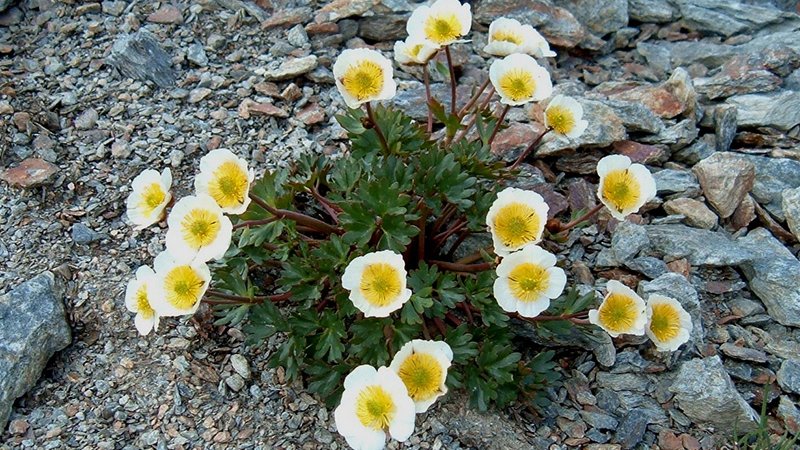The nival zone, found above 3000m, is characterized by vegetation (called associations) that lives on rocks and gravel with few areas of continuous meadow. The plants living here only grow in conditions with high exposure to sunlight and are unable to survive in dense populations. Surprisingly, even though conditions are extremely unfavorable, there are more than 100 species of flowering plants. Of certain notoriety and almost synonymous with the Alps is the Glacier Crowfoot or Buttercup (Ranunculus glacialis), which is ideally adapted to these rough conditions. Life is even found in the zone of permanent snow and ice cover. These microscopic “plants” are noticeable as pink patches of snow (“Blutschnee”) and can be ascribed to mass populations of the Snow Algae (Clamydomonas nivalis). The toughest and most resistant inhabitants of the nival zone are the diverse species of lichens which are symbiotic organisms made up of algae and fungi. Certain lichens are presumably as old as 10,000 years as they date back to the end of the last ice age. They grow on bare rock and only increase a fraction of a millimeter in size every year. In order to grow and survive such low temperatures as well as extreme heat, they need water, air and sun. They accomplish this by acquiring water and carbon dioxide from the air. In the Ötz valley, the Map Lichen (Rhizocarpon geograficum) is a memorable sight.
Typical species of plants (some of which are protected!):
- Green Algae (Staurastum gurgliense)
- Map Lichen (Rhizocarpon geographicum)
- Crystalwart (Riccia breidleri)
- Little grapefern (Botrychium simplex)
- Black Spleenwort (Asplenium adiantum-nigrum)
- Curved Sedge (Carex curvula)
- Burnt Orchid (Orchis ustulata)
- Globe Orchid (Traunsteinera globosa)
- Yellow Mountain Saxifrage (Saxifraga aizoides)
- Purple Gentian (Gentiana purpurea)
- Black Vanilla Orchid (Nigritella nigra)
- Rusty-leaved Alpenrose (Rhododendron ferrugineum)
- Sweet Clover (Trifolium saxatile)
- Glacier Buttercup (Ranunculus glacialis)














